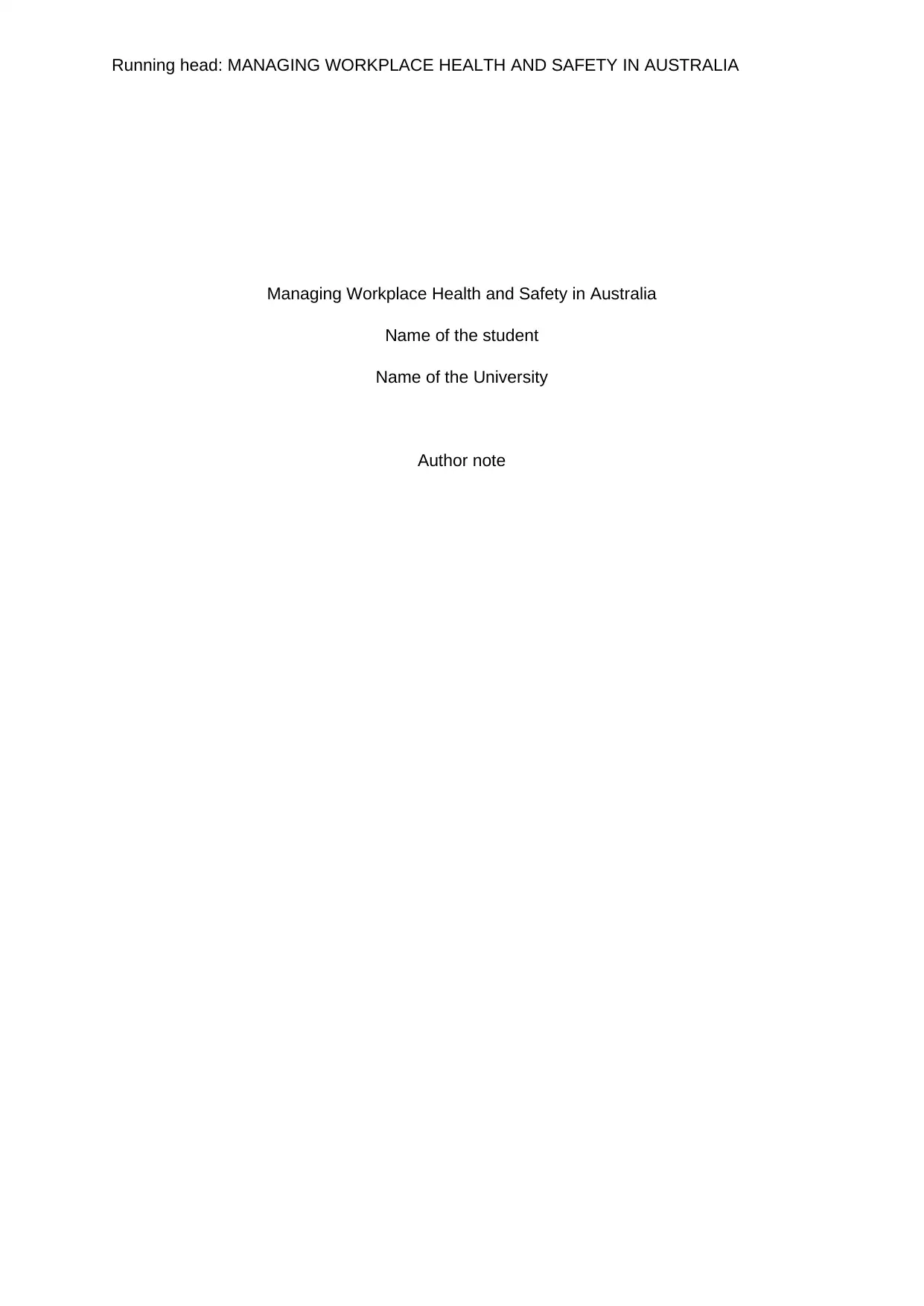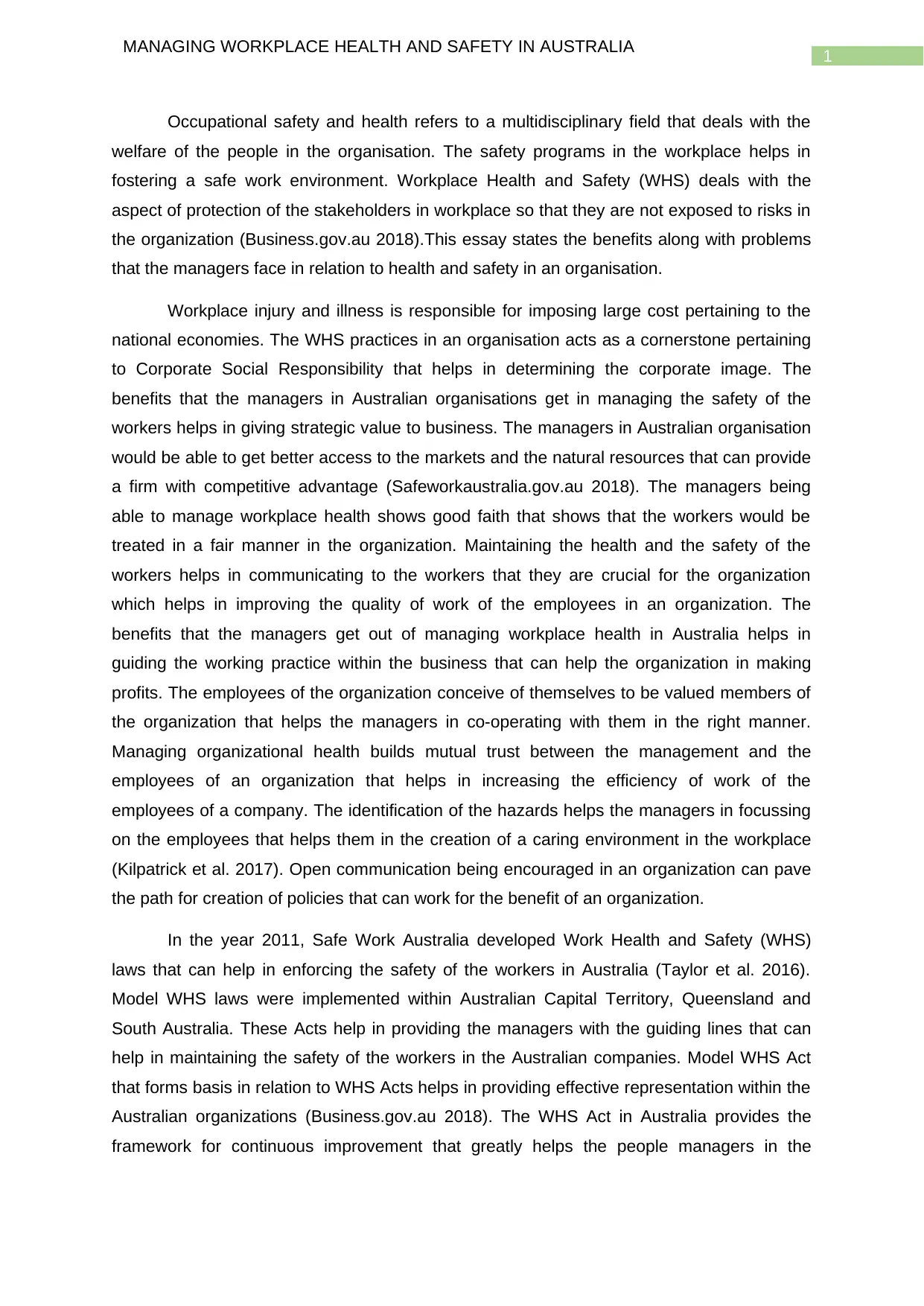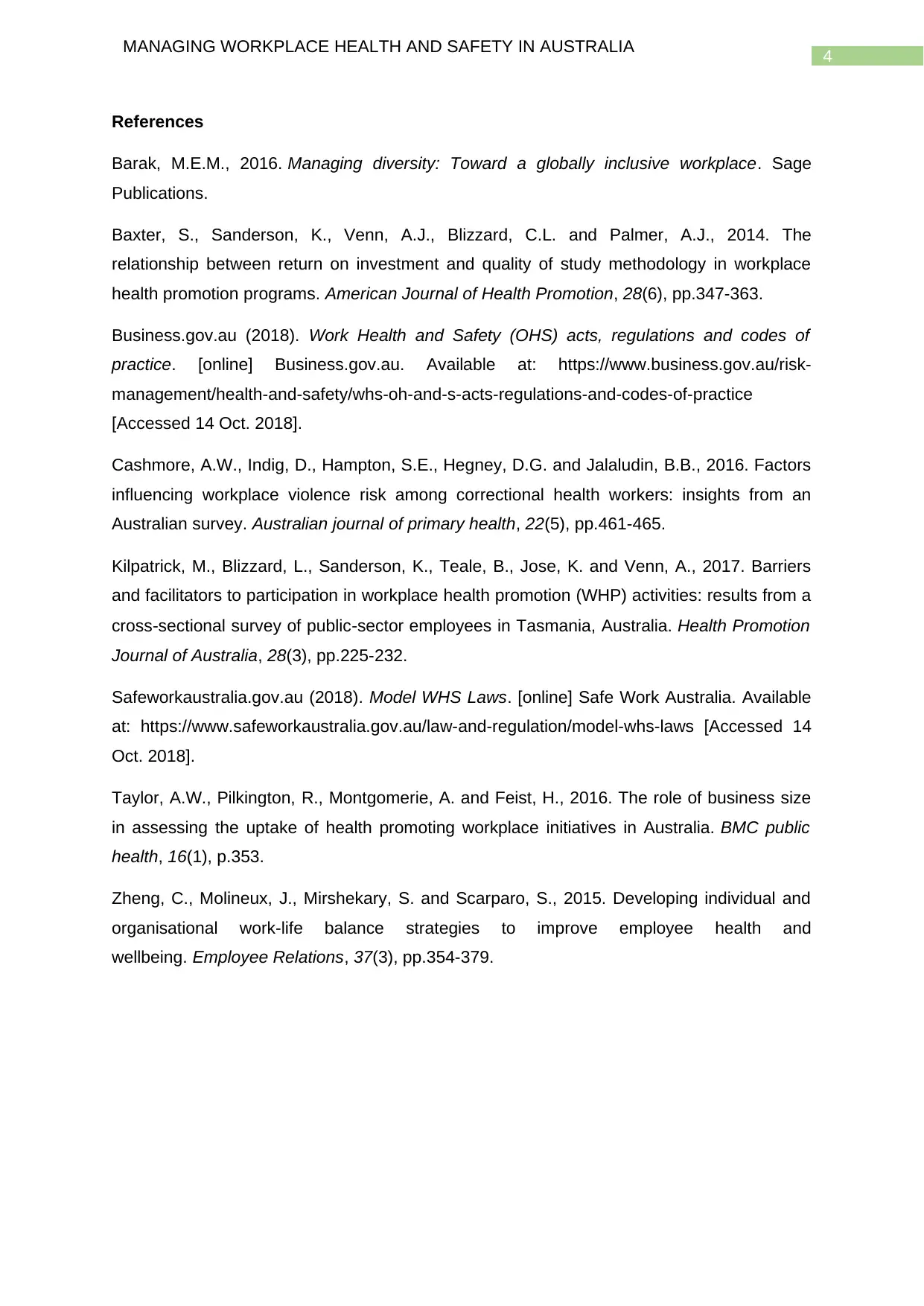Strategic Workplace Health and Safety in Australian Firms
VerifiedAdded on 2023/06/03
|5
|1504
|237
Essay
AI Summary
This essay explores the critical aspects of managing workplace health and safety (WHS) in Australian organizations, emphasizing its role in corporate social responsibility and strategic business value. It highlights the benefits managers gain from prioritizing worker safety, such as improved market access, enhanced corporate image, and increased employee engagement. The essay also addresses the challenges managers face, including resource constraints, lack of upper management support, mental overload of employees, and inadequate feedback mechanisms. Furthermore, it discusses the impact of the Work Health and Safety (WHS) laws developed in 2011, which provide guidelines for maintaining worker safety and encourage union involvement. The essay concludes by underscoring the importance of addressing these challenges to foster a safe and productive work environment in Australian organizations. Desklib provides a platform for students to access past papers and solved assignments related to this topic.

Running head: MANAGING WORKPLACE HEALTH AND SAFETY IN AUSTRALIA
Managing Workplace Health and Safety in Australia
Name of the student
Name of the University
Author note
Managing Workplace Health and Safety in Australia
Name of the student
Name of the University
Author note
Paraphrase This Document
Need a fresh take? Get an instant paraphrase of this document with our AI Paraphraser

1
MANAGING WORKPLACE HEALTH AND SAFETY IN AUSTRALIA
Occupational safety and health refers to a multidisciplinary field that deals with the
welfare of the people in the organisation. The safety programs in the workplace helps in
fostering a safe work environment. Workplace Health and Safety (WHS) deals with the
aspect of protection of the stakeholders in workplace so that they are not exposed to risks in
the organization (Business.gov.au 2018).This essay states the benefits along with problems
that the managers face in relation to health and safety in an organisation.
Workplace injury and illness is responsible for imposing large cost pertaining to the
national economies. The WHS practices in an organisation acts as a cornerstone pertaining
to Corporate Social Responsibility that helps in determining the corporate image. The
benefits that the managers in Australian organisations get in managing the safety of the
workers helps in giving strategic value to business. The managers in Australian organisation
would be able to get better access to the markets and the natural resources that can provide
a firm with competitive advantage (Safeworkaustralia.gov.au 2018). The managers being
able to manage workplace health shows good faith that shows that the workers would be
treated in a fair manner in the organization. Maintaining the health and the safety of the
workers helps in communicating to the workers that they are crucial for the organization
which helps in improving the quality of work of the employees in an organization. The
benefits that the managers get out of managing workplace health in Australia helps in
guiding the working practice within the business that can help the organization in making
profits. The employees of the organization conceive of themselves to be valued members of
the organization that helps the managers in co-operating with them in the right manner.
Managing organizational health builds mutual trust between the management and the
employees of an organization that helps in increasing the efficiency of work of the
employees of a company. The identification of the hazards helps the managers in focussing
on the employees that helps them in the creation of a caring environment in the workplace
(Kilpatrick et al. 2017). Open communication being encouraged in an organization can pave
the path for creation of policies that can work for the benefit of an organization.
In the year 2011, Safe Work Australia developed Work Health and Safety (WHS)
laws that can help in enforcing the safety of the workers in Australia (Taylor et al. 2016).
Model WHS laws were implemented within Australian Capital Territory, Queensland and
South Australia. These Acts help in providing the managers with the guiding lines that can
help in maintaining the safety of the workers in the Australian companies. Model WHS Act
that forms basis in relation to WHS Acts helps in providing effective representation within the
Australian organizations (Business.gov.au 2018). The WHS Act in Australia provides the
framework for continuous improvement that greatly helps the people managers in the
MANAGING WORKPLACE HEALTH AND SAFETY IN AUSTRALIA
Occupational safety and health refers to a multidisciplinary field that deals with the
welfare of the people in the organisation. The safety programs in the workplace helps in
fostering a safe work environment. Workplace Health and Safety (WHS) deals with the
aspect of protection of the stakeholders in workplace so that they are not exposed to risks in
the organization (Business.gov.au 2018).This essay states the benefits along with problems
that the managers face in relation to health and safety in an organisation.
Workplace injury and illness is responsible for imposing large cost pertaining to the
national economies. The WHS practices in an organisation acts as a cornerstone pertaining
to Corporate Social Responsibility that helps in determining the corporate image. The
benefits that the managers in Australian organisations get in managing the safety of the
workers helps in giving strategic value to business. The managers in Australian organisation
would be able to get better access to the markets and the natural resources that can provide
a firm with competitive advantage (Safeworkaustralia.gov.au 2018). The managers being
able to manage workplace health shows good faith that shows that the workers would be
treated in a fair manner in the organization. Maintaining the health and the safety of the
workers helps in communicating to the workers that they are crucial for the organization
which helps in improving the quality of work of the employees in an organization. The
benefits that the managers get out of managing workplace health in Australia helps in
guiding the working practice within the business that can help the organization in making
profits. The employees of the organization conceive of themselves to be valued members of
the organization that helps the managers in co-operating with them in the right manner.
Managing organizational health builds mutual trust between the management and the
employees of an organization that helps in increasing the efficiency of work of the
employees of a company. The identification of the hazards helps the managers in focussing
on the employees that helps them in the creation of a caring environment in the workplace
(Kilpatrick et al. 2017). Open communication being encouraged in an organization can pave
the path for creation of policies that can work for the benefit of an organization.
In the year 2011, Safe Work Australia developed Work Health and Safety (WHS)
laws that can help in enforcing the safety of the workers in Australia (Taylor et al. 2016).
Model WHS laws were implemented within Australian Capital Territory, Queensland and
South Australia. These Acts help in providing the managers with the guiding lines that can
help in maintaining the safety of the workers in the Australian companies. Model WHS Act
that forms basis in relation to WHS Acts helps in providing effective representation within the
Australian organizations (Business.gov.au 2018). The WHS Act in Australia provides the
framework for continuous improvement that greatly helps the people managers in the

2
MANAGING WORKPLACE HEALTH AND SAFETY IN AUSTRALIA
Australian organization. The WHS Act encourages the unions in taking constructive role that
can act to the benefit for the managers in Australian organizations.
The managers face problems in managing workplace health owing to the dearth of
resources in an organization. There are constant changes taking place within work
community that has an effect on the ability of people managers to support well-being of
employees in Australia. The people managers in Australian organizations have the
responsibility of promoting good relations among the employees of an organization. They
have the responsibility of actively solving the problems within work community. The people
managers in Australia however lack power as the personnel in the upper management
ignore the legal duty of managing the risks (Cashmore et al. 2016). The people managers in
Australian organizations delegate issue to the first-line supervisor within an organisation
without providing any kind of resources that becomes a barrier in the path of implementation
of workplace health along with safety laws. The people managers in Australia do not get the
support from the upper management and the tight economic situation prevailing in the
Australian organization makes it difficult for the managers to implement the workplace safety
regulations (Baxter et al. 2014).
The managers face problems in managing health of the employees because of the
mental overload of the employees in the Australian organizations. The managers do not get
feedback from the employees that makes it difficult for them in the implementation of safety
programs in the Australian organizations (Zheng et al. 2015). The managers in an
organization need the tools that can help them in meeting the responsibilities in the
Australian organizations. The managers do not get the peer support from the colleagues that
becomes a problem for the people managers in Australian organizations (Barak 2016). Peer
support system can act to the benefit of new managers that can help him in serving the
employees in an organization. The organizational health and safety procedures are not well-
developed that creates problem for the managers in Australia in implementation of safety
programs in the organizations.
Workplace injury is responsible for imposing large amount of cost on national
economy. Managing the aspect of organizational health can build mutual trust between
managers and employees of an organization. It can increase efficiency of the workers within
the ambit of the Australian organizations. The management in an organisation abiding by
WHS practices helps the company in evolving as a socially responsible company. The
development of WHS laws in 2011 helped in the implementation of laws that looked after the
welfare of employees in Australian organizations. The unions play a constructive role in
implementing WHS Act in the Australian organizations. Inadequate resources acts as an
MANAGING WORKPLACE HEALTH AND SAFETY IN AUSTRALIA
Australian organization. The WHS Act encourages the unions in taking constructive role that
can act to the benefit for the managers in Australian organizations.
The managers face problems in managing workplace health owing to the dearth of
resources in an organization. There are constant changes taking place within work
community that has an effect on the ability of people managers to support well-being of
employees in Australia. The people managers in Australian organizations have the
responsibility of promoting good relations among the employees of an organization. They
have the responsibility of actively solving the problems within work community. The people
managers in Australia however lack power as the personnel in the upper management
ignore the legal duty of managing the risks (Cashmore et al. 2016). The people managers in
Australian organizations delegate issue to the first-line supervisor within an organisation
without providing any kind of resources that becomes a barrier in the path of implementation
of workplace health along with safety laws. The people managers in Australia do not get the
support from the upper management and the tight economic situation prevailing in the
Australian organization makes it difficult for the managers to implement the workplace safety
regulations (Baxter et al. 2014).
The managers face problems in managing health of the employees because of the
mental overload of the employees in the Australian organizations. The managers do not get
feedback from the employees that makes it difficult for them in the implementation of safety
programs in the Australian organizations (Zheng et al. 2015). The managers in an
organization need the tools that can help them in meeting the responsibilities in the
Australian organizations. The managers do not get the peer support from the colleagues that
becomes a problem for the people managers in Australian organizations (Barak 2016). Peer
support system can act to the benefit of new managers that can help him in serving the
employees in an organization. The organizational health and safety procedures are not well-
developed that creates problem for the managers in Australia in implementation of safety
programs in the organizations.
Workplace injury is responsible for imposing large amount of cost on national
economy. Managing the aspect of organizational health can build mutual trust between
managers and employees of an organization. It can increase efficiency of the workers within
the ambit of the Australian organizations. The management in an organisation abiding by
WHS practices helps the company in evolving as a socially responsible company. The
development of WHS laws in 2011 helped in the implementation of laws that looked after the
welfare of employees in Australian organizations. The unions play a constructive role in
implementing WHS Act in the Australian organizations. Inadequate resources acts as an
⊘ This is a preview!⊘
Do you want full access?
Subscribe today to unlock all pages.

Trusted by 1+ million students worldwide

3
MANAGING WORKPLACE HEALTH AND SAFETY IN AUSTRALIA
impediment pertaining to application of the safety programs in the various business
organisations within Australia. The people in upper management ignore the aspect of legal
duty that makes the people managers powerless in implementing safety laws. Changes
occurring within work community creates problem for Australian managers in taking into
cognizance the safety laws related to workplace. Managers are not able to get feedback
from employees that makes them incapable of implementing safety programs in Australia.
Managers not receiving peer support from colleagues acts as a hurdle for people managers
in managing safety of employees.
MANAGING WORKPLACE HEALTH AND SAFETY IN AUSTRALIA
impediment pertaining to application of the safety programs in the various business
organisations within Australia. The people in upper management ignore the aspect of legal
duty that makes the people managers powerless in implementing safety laws. Changes
occurring within work community creates problem for Australian managers in taking into
cognizance the safety laws related to workplace. Managers are not able to get feedback
from employees that makes them incapable of implementing safety programs in Australia.
Managers not receiving peer support from colleagues acts as a hurdle for people managers
in managing safety of employees.
Paraphrase This Document
Need a fresh take? Get an instant paraphrase of this document with our AI Paraphraser

4
MANAGING WORKPLACE HEALTH AND SAFETY IN AUSTRALIA
References
Barak, M.E.M., 2016. Managing diversity: Toward a globally inclusive workplace. Sage
Publications.
Baxter, S., Sanderson, K., Venn, A.J., Blizzard, C.L. and Palmer, A.J., 2014. The
relationship between return on investment and quality of study methodology in workplace
health promotion programs. American Journal of Health Promotion, 28(6), pp.347-363.
Business.gov.au (2018). Work Health and Safety (OHS) acts, regulations and codes of
practice. [online] Business.gov.au. Available at: https://www.business.gov.au/risk-
management/health-and-safety/whs-oh-and-s-acts-regulations-and-codes-of-practice
[Accessed 14 Oct. 2018].
Cashmore, A.W., Indig, D., Hampton, S.E., Hegney, D.G. and Jalaludin, B.B., 2016. Factors
influencing workplace violence risk among correctional health workers: insights from an
Australian survey. Australian journal of primary health, 22(5), pp.461-465.
Kilpatrick, M., Blizzard, L., Sanderson, K., Teale, B., Jose, K. and Venn, A., 2017. Barriers
and facilitators to participation in workplace health promotion (WHP) activities: results from a
cross‐sectional survey of public‐sector employees in Tasmania, Australia. Health Promotion
Journal of Australia, 28(3), pp.225-232.
Safeworkaustralia.gov.au (2018). Model WHS Laws. [online] Safe Work Australia. Available
at: https://www.safeworkaustralia.gov.au/law-and-regulation/model-whs-laws [Accessed 14
Oct. 2018].
Taylor, A.W., Pilkington, R., Montgomerie, A. and Feist, H., 2016. The role of business size
in assessing the uptake of health promoting workplace initiatives in Australia. BMC public
health, 16(1), p.353.
Zheng, C., Molineux, J., Mirshekary, S. and Scarparo, S., 2015. Developing individual and
organisational work-life balance strategies to improve employee health and
wellbeing. Employee Relations, 37(3), pp.354-379.
MANAGING WORKPLACE HEALTH AND SAFETY IN AUSTRALIA
References
Barak, M.E.M., 2016. Managing diversity: Toward a globally inclusive workplace. Sage
Publications.
Baxter, S., Sanderson, K., Venn, A.J., Blizzard, C.L. and Palmer, A.J., 2014. The
relationship between return on investment and quality of study methodology in workplace
health promotion programs. American Journal of Health Promotion, 28(6), pp.347-363.
Business.gov.au (2018). Work Health and Safety (OHS) acts, regulations and codes of
practice. [online] Business.gov.au. Available at: https://www.business.gov.au/risk-
management/health-and-safety/whs-oh-and-s-acts-regulations-and-codes-of-practice
[Accessed 14 Oct. 2018].
Cashmore, A.W., Indig, D., Hampton, S.E., Hegney, D.G. and Jalaludin, B.B., 2016. Factors
influencing workplace violence risk among correctional health workers: insights from an
Australian survey. Australian journal of primary health, 22(5), pp.461-465.
Kilpatrick, M., Blizzard, L., Sanderson, K., Teale, B., Jose, K. and Venn, A., 2017. Barriers
and facilitators to participation in workplace health promotion (WHP) activities: results from a
cross‐sectional survey of public‐sector employees in Tasmania, Australia. Health Promotion
Journal of Australia, 28(3), pp.225-232.
Safeworkaustralia.gov.au (2018). Model WHS Laws. [online] Safe Work Australia. Available
at: https://www.safeworkaustralia.gov.au/law-and-regulation/model-whs-laws [Accessed 14
Oct. 2018].
Taylor, A.W., Pilkington, R., Montgomerie, A. and Feist, H., 2016. The role of business size
in assessing the uptake of health promoting workplace initiatives in Australia. BMC public
health, 16(1), p.353.
Zheng, C., Molineux, J., Mirshekary, S. and Scarparo, S., 2015. Developing individual and
organisational work-life balance strategies to improve employee health and
wellbeing. Employee Relations, 37(3), pp.354-379.
1 out of 5
Related Documents
Your All-in-One AI-Powered Toolkit for Academic Success.
+13062052269
info@desklib.com
Available 24*7 on WhatsApp / Email
![[object Object]](/_next/static/media/star-bottom.7253800d.svg)
Unlock your academic potential
Copyright © 2020–2025 A2Z Services. All Rights Reserved. Developed and managed by ZUCOL.





